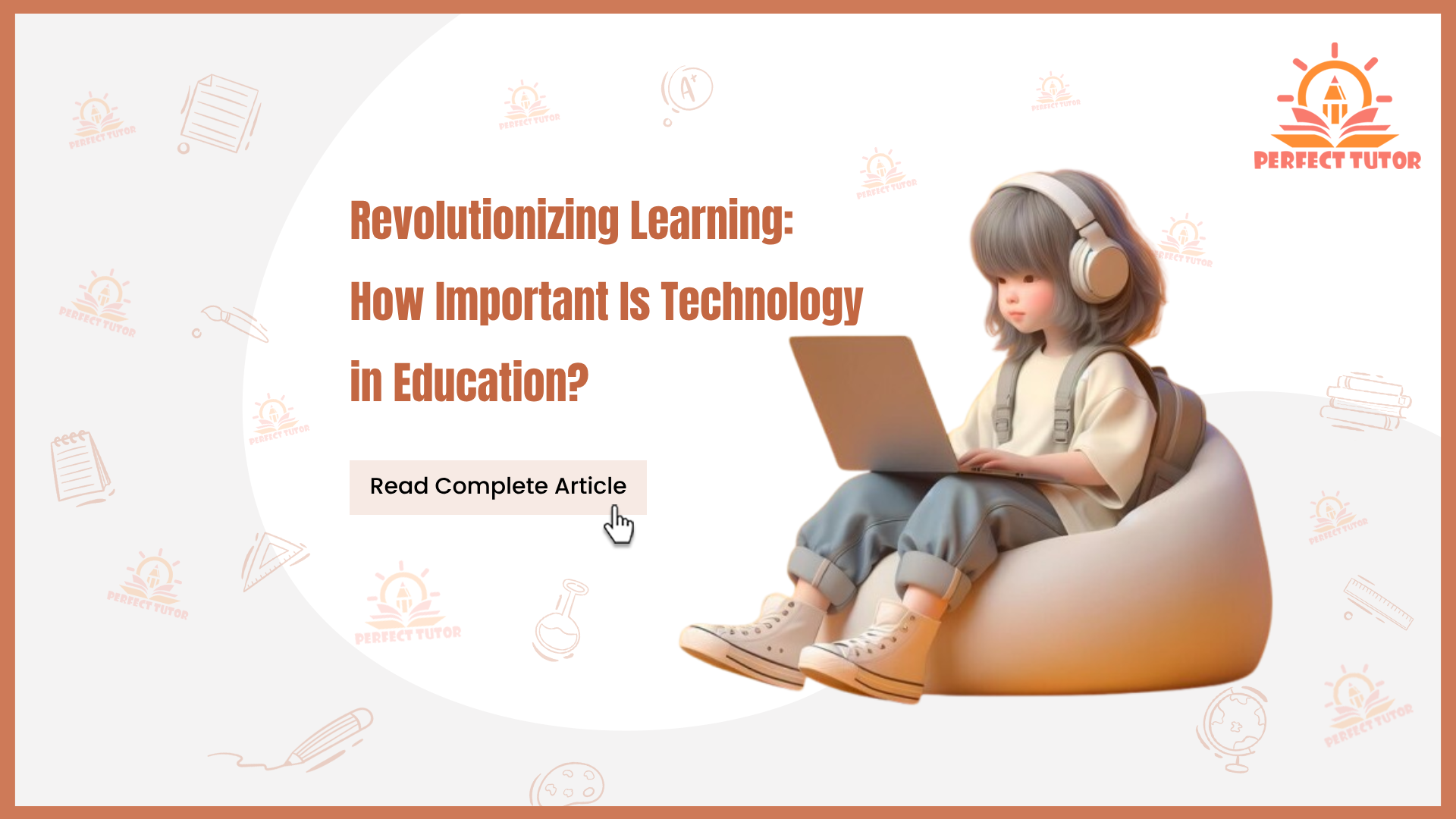Revolutionizing Learning: How Important Is Technology in Education?
Education has always been the basis of personal and social development. But in today's fast-paced world, technology has revolutionized the way we learn and teach. Be it online classes, interactive apps, or virtual simulations, technology in education has made learning more engaging, accessible, and effective.
In this blog, you will learn how technology reshapes education, why it is so important, and how students, teachers, and parents can benefit from this digital evolution. Perfect Tutor aims to guide you on this exciting journey and help you understand why integrating technology into education is essential in today's world.
What Makes Technology in Education So Important?
From increasing accessibility to personalizing lessons, it has revolutionized the way students learn and teachers teach. Here's a closer look at why technology is so important in education.
1. Enhancing Accessibility
The most important contribution of technology is its ability to break barriers in education. Students living in remote areas can now access the same quality education as those in urban centres through online platforms. Virtual classes, e-books and recorded lectures make it possible for anyone with an internet connection to learn from top teachers.
2. Improving Engagement
Traditional teaching methods often struggle to capture students' attention. Technology addresses this problem by introducing interactive tools such as videos, quizzes, and simulations. These methods make lessons more engaging and fun, helping students to remember information better.
3. Personalizing Education
Every student learns at his or her own pace. Technology makes it easy to meet individual needs through adaptive learning platforms. These tools assess student strengths and weaknesses and create personalized learning plans, ensuring no one is left behind.
4. Preparing for the Future
Incorporating technology into education gives students the skills they need for the modern workplace. From the use of digital tools to the development of problem-solving and critical thinking abilities, technology prepares students for real-world challenges.
5. Encouraging Collaboration
Digital tools make collaboration easier and more efficient. Students can work on group projects, participate in online discussions, or connect with peers around the world through shared documents. This collaborative approach builds teamwork and communication skills.
6. Expanding Teacher Capabilities
For teachers, technology is a powerful tool. It helps them track students' progress, identify areas of improvement, and use creative teaching methods. Tools like smartboards and educational apps make lessons more dynamic and effective.
The Role of Technology in Modern Classrooms
Today's students learn and interact in classrooms in ways that are far beyond traditional methods, thanks to the integration of technology. Here's how modern students engage in the learning process:
Tablets and Laptops: Students use personal devices for quick access to online resources, research, and collaboration tools. These devices allow them to actively participate in lessons, perform experiments, and explore educational apps.
Interactive Whiteboards: Smartboards allow teachers to display multimedia content such as videos, animations, and diagrams, making learning more interactive and visually engaging. Students can also contribute to writing or solve problems using the board.
Adaptive Learning Platforms: Technology enables personalized learning by adjusting content to each student’s needs. Apps and platforms help students work at their own pace, allowing them to spend more time on challenging topics.
Online Tutors: Students can get personalized support through online tutoring services, which provide individualized help on specific topics or concepts.
Virtual Classrooms and Communication Tools: Platforms like Google Classroom, Zoom, and Microsoft Teams make it easy for students to collaborate on assignments, engage in discussions, and work on projects together, whether they’re in the classroom or remotely.
Group Projects and Shared Documents: Tools like Google Docs allow students to collaborate in real-time on documents, presentations, and research, promoting teamwork and communication skills.
Virtual and Augmented Reality: Using AR and VR technologies, students can explore 3D models and historical events or perform virtual experiments. This immersive learning experience helps them understand complex concepts more effectively.
Digital Assessments: Online quizzes, assignments, and tests provide instant feedback, helping students understand their strengths and areas of improvement. Teachers can use technology to track student's progress and adjust their teaching methods accordingly.
How Perfect Tutor Integrates Technology in Education
Perfect Tutor is a leading home tuition provider in India, leveraging technology to enhance the learning experience for students across the country. Here is how technology is used in the services offered:
Online Tutoring Platforms: Perfect Tutor connects students with qualified tutors through online platforms, allowing flexible learning at home. These platforms include video conferencing tools like Zoom and Google Meet, which ensure clear communication and interaction during sessions.
Learning Management System (LMS): Perfect Tutor uses an LMS to organize lessons, assignments, and progress tracking. This system allows tutors and students to access learning content, submit assignments, and monitor progress in real time, creating an organized, streamlined experience.
Digital Tools for Interactive Learning: Perfect Tutor's teachers use digital resources like smartboards and educational apps to make learning more interesting. Interactive exercises, quizzes, and visual aids help students understand complex topics in an entertaining and accessible way.
Personalized Learning through Technology: Perfect Tutor uses technology to decide lessons for individual student needs. AI-powered tools analyze performance and suggest customized learning paths, helping students learn at their own pace and address areas where they need improvement.
Availability of E-books and Online Resources: Perfect Tutor provides access to a wide range of digital learning materials, such as e-books and videos, that complement traditional teaching methods. These resources make it easier for students to access information, practice skills, and revise concepts.
Regular Feedback and Assessments: Through digital assessments, teachers can provide real-time feedback to students. These assessments help track progress and identify areas of improvement, ensuring students get the support they need to succeed.
Benefits of Technology in Education
Technology has transformed education in many ways, bringing numerous benefits that enhance the learning experience for both students and teachers. Here are some of the key benefits:
1. Encourages Collaboration: Online tools such as group projects, discussion forums, and collaborative assignments help students work together, connecting them globally and enhancing teamwork skills.
2. Supports Diverse Learning Styles: Technology caters to different learning styles – visual learners can watch videos, auditory learners can listen to podcasts, and kinesthetic learners can engage with interactive simulations.
3. Promotes Lifelong Learning: With round-the-clock access to resources, technology encourages continuous learning. Platforms like MOOCs (Massive Open Online Courses) allow people of all ages to learn at their own pace.
4. Saves Time and Resources: Digital tools reduce paper use, making education more eco-friendly. Teachers can also automate tasks like grading, allowing them to focus more on teaching.
Challenges and Solutions in Adopting Technology in Education
While technology offers many educational benefits, there are several challenges that schools, teachers, and students face when integrating new technological tools. Here are some common challenges and ways to overcome them:
1. Digital Divide
Challenge: Not all students have equal access to technology. In many areas, students may lack the devices, reliable internet, or infrastructure necessary to access online education.
Solution: Schools and governments can invest in affordable devices, subsidize internet access, and set up community centres or public Wi-Fi hubs to ensure equal access for all students.
2. Teacher Training
Challenge: Teachers may not be adequately trained to effectively use new technology in their classrooms. This can hinder the adoption of educational tools and reduce their effectiveness.
Solution: Continuous professional development and training programs should be provided to help teachers become proficient in using educational technology. Offering practical workshops and providing easy-to-use technological tools can build confidence in teachers.
3. Resistance to Change
Challenge: Some teachers, students, or parents may be resistant to the use of technology in education due to a preference for traditional teaching methods or unfamiliarity with new tools.
Solution: Introduce technology gradually by demonstrating its value through small pilot programs. Encourage open discussion about the benefits, address concerns and provide support to ease the transition.
4. Security and Privacy Concerns
Challenge: Online platforms and digital tools can expose students and teachers to privacy risks and cybersecurity threats, especially when sensitive personal information is involved.
Solution: Schools should implement strong data security policies, including encryption, secure passwords, and two-factor authentication. It is also essential to educate students and parents about safe online practices.
5. Technology Overload and Distractions
Challenge: Due to the increasing use of digital devices, students may get distracted by social media, games or other non-academic content while studying.
Solution: Schools can use software that limits distractions by blocking non-academic websites or apps during class time. Setting clear guidelines for device use and promoting digital literacy can also help students focus on their studies.
6. Cost of Implementation
Challenge: Technology can be costly to implement and maintain, especially for schools with limited budgets. Buying devices, software licenses, and paying for internet access may be out of reach for some institutions.
Solution: Schools can seek grants, government funding, or partnerships with tech companies to reduce costs. Additionally, open-source software and free educational apps can help ease the financial burden.
The Future of Education with Technology
Technology is rapidly shaping the future of education, offering exciting possibilities to transform learning experiences. Here's how technology will continue to impact education:
Personalized Learning:
The AI-powered platforms will create lessons and content according to the learning pace and preferences of each student.
Adaptive learning tools will ensure that students receive content based on their strengths and address their weaknesses.
Global Access to Education:
Virtual classes and online learning platforms will allow students to access quality education from anywhere in the world.
This global reach cuts across barriers related to geography, economic background, and language.
AI and Automation:
Artificial intelligence will assist with grading, administrative tasks, and even tutoring, reducing teachers’ workload and providing more time to connect with students individually.
Automation will streamline lesson plans and provide real-time feedback to students.
Virtual and Augmented Reality (VR/AR):
VR/AR will provide students with interactive, hands-on learning experiences that traditional methods cannot provide.
From exploring distant planets to conducting scientific experiments, students can experience learning in a whole new way.
Lifelong Learning:
Technology will continue to make learning more accessible, and platforms offering courses for all age groups will be available.
Students can upskill or reskill throughout their careers, ensuring they stay relevant in the ever-changing job market.
FAQs about Technology in Education
1. How important is technology in education today?
Technology is important to modern education as it enhances the learning experience, improves access, and prepares students for a tech-driven world.
2. What are the benefits of integrating technology in education?
It promotes personalized learning, increases engagement, saves resources, and supports diverse learning styles.
3. How does technology help teachers?
It automates administrative tasks, provides real-time performance information, and enables innovative teaching methods.
4. What are the challenges of using technology in education?
Challenges include the digital divide, lack of teacher training, and cybersecurity issues. Solutions include better infrastructure, training programs, and secure platforms.
5. Why should I choose Perfect Tutor for my child’s education?
Perfect Tutor combines expert teaching with advanced technology to deliver personalized, effective learning tailored to the needs of each student.
Q3: How does technology help in online tutoring?
Online tutoring platforms like Perfect Tutor use video calls, interactive tools, and AI to make lessons more effective.
Q4: Can technology replace traditional teaching methods?
Although technology enhances learning, it complements rather than replaces the human touch in education.
Conclusion
Technology in education is no longer a luxury – it has become a necessity. It makes learning accessible, personalized, and engaging for students of all ages. By embracing this change, teachers and parents can prepare children for a bright future.
At Perfect Tutor, we understand the importance of technology in education. Our platform connects students with expert tutors who use the latest tools to make learning effective.



 +91 8700847275
+91 8700847275
 +1 8009616567
+1 8009616567